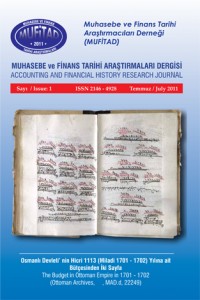Abstract
Muhasebenin insanlığın var olduğundan beri uygulandığı bilinmektedir. Muhasebenin
tarihi gelişimi incelendiğinde muhasebede kullanılan kayıtlama yöntemlerini tek taraflı ve
çift taraflı kayıtlama olarak özetlemek mümkündür. Bunlardan ilk kullanılanı tek taraflı
kayıtlamadır. Bu kayıtlamaya göre muhasebe ile ilgili bilgilerin tamamı değil, amaçlanan
kısmı veya kısımları kayda alınır. Alacakların, borçların, gelir ve giderlerin takibini tek
taraflı kayıtlamaya örnek olarak verebiliriz.
Tek taraflı kayıtlamada, alacak ve borçlar takip edilirken, bunlara ait tahsilat ve
ödemeler ayrıca başka hesaplarda kaydedilmez. Gelir ve giderler takip edilirken gelirin
tahsilinde ve giderin ödenmesindeki nakit giriş ve çıkışları da ayrıca diğer hesaplarda
izlenmez. Kitab-us Siyakat’te bu tür kayıtlamalar yapılmıştır. Bu nedenle, Kitab-us
Siyakat’teki kayıtlama yöntemi, kesinlikle tek taraflı kayıtlama değildir. Sistemin tümü ve
kullanılan defterler incelendiğinde bu durumu açık bir şekilde görmek mümkündür.
Çift taraflı kayıtlamada ise temelde varlık, kaynak, gelir, gider ve sonuçla (kar/zarargelir
gider farkıyla) ilgili bilgilerin tamamının izlenmesi amaçlanır. Araştırma konumuzu
oluşturan Kitab-us Siyakat’te, devlet muhasebesinde kullanılan “merdiven yöntemi”
açıklanmaktadır. Devlet bütçe gelir ve giderlerinin izlenmesinde kullanılan bu yöntem
Osmanlı devletinde 500, Ortadoğu’da 1.100 yıla yakın bir süre kullanılmıştır. Bu yöntem
Ortadoğu devletlerinden Abbasiler tarafından bulunmuş, İlhanlılar tarafından geliştirilmiş
ve Osmanlı İmparatorluğu’nda da olgunlaştırılarak uygulanmıştır. Bu kitap, Luca
Pacioli’den 131 yıl önce yazılmıştır (1363).
Sistemin tümü incelendiğinde, bu kitapta kullanılan defter-i kebir hesaplarını, bütçe
gelirleri, bütçe giderleri, hazine, alacak, borç ve sonuç (gelir-gider farkı) olarak özetlemek
mümkündür. Bu hesaplara kaydedilen borç ve alacak tutarları da eşittir. Yalnız, defter-i
kebir hesaplarına ait tutarlar borç ve alacak tutarı şeklinde ayrı ayrı değil, istenileni kısa
yoldan ifade etmek olan siyakat yazı sistemi’nin özelliğine uygun olarak borçlandırılacak
ve alacaklandırılacak hesaplar için tek tutar şeklinde kaydedilmiştir. Bu uygulama, çift
taraflı kayıtlamaya aykırı bir sonuç yaratmaz.
Muhasebe tarihinin duayeni olan Stevelinck, bu tebliğin yazarlarından Prof. Dr. Remzi
Örten’e Ortadoğu’da Luca Pacioli’den önce çift taraflı kayıtlamanın açıklandığı bir kitabın
yazıldığını, buna ait bilginin İstanbul’daki Süleymaniye Kütüphanesinde olduğunu
bildirmişti. Bunun üzerine Prof. Dr. Remzi Örten’in de başkanı olduğu komisyonda bu
eser incelenmiş, ancak çeviri yapanın muhasebe teknik bilgisi olmayan bir dil uzmanı
olması nedeniyle çift taraflı kayıtlamanın bu kitapta yazıldığı sağlıklı bir şekilde
anlaşılamamıştı.
12. Dünya Muhasebe tarihçileri Kongresi için yaptığımız daha ayrıntılı bir araştırma,
inceleme ve değerlendirmede Stevelinck’in yazmış olduklarının doğru olduğu ve çift
taraflı kayıtlama yöntemine ait temel esasların adı geçen kitapta açıklandığı sonucuna
varılmıştı.
Bu çalışmamızda, 12. Dünya Muhasebe Tarihçileri Kongresi’nde sunduğumuz tebliğin
Kitab-us Siyakat’e ve çift taraflı kayıtlamaya ait kısmı esas alınmıştır. Bu çalışmanın
amacı, çift taraflı kayıtlama yöntemine ilişkin temel esasların bu kitapta var olduğunun
yeniden gözden geçirilmesi ve ilgililere daha kolay anlaşılır bir şekilde sunulmasıdır.
Abstract
It is known that accounting is applied since the existence of human being. When
historical development of accounting is examined, recording methods may be
summarized as single sided and double sided. The first method used in accounting is the
single entry bookkeeping. According to this entry, not all of information related to
financial events but important part of them are recorded in a single way. We can specify
follow-up of receivable, payable, incomes and expenses as single sided recording.
In the single entry bookkeeping, while receivables and payables are registered a
financial event is recorded in a single account and collection related to receivables and
payment concerning the liabilities are not recorded. While incomes and expenses are
recorded, collection and payment related to incomes and expenses are not recorded
either. In double entry bookkeeping, following-up all information concerning the financial
events are recorded at least in two accounts related to asset, source, income, expense,
profit/loss (difference of incomes and expenses). The ledger accounts used in Kitab-us
Siyakat can be summarized as follows; budget income, budget expense, treasury,
receivable, payable and result accounts. The debit sum written to one of these accounts
is equal to the credit sum of other. Therefore, the recording method in Kitab-us Siyakat is
not definitely the single entry bookkeeping and contains the basic principles and
applications of double entry bookkeeping. It is possible to see this situation when
examining the whole system and books used in Kitab-us Siyakat. Kitab-us Siyakat which
constitutes our subject of research is a book used in state (government) accounting. This
book contains the basic principles of double entry bookkeeping.
Stairs method explained in Kitab-us Siyakat was used in income and expense of
government budget for the period of 500 years in the Ottoman Empire and 1100 years in
the Middle East. This method was found by Abbasids, developed by Ilkhanids and
applied in the Ottoman Empire by maturing. This book was written 131 years before than
Luca Pacioli’s book (1363).
This book is the most developed and famous one written in Ilkhanid period among
four basic accounting books.
A basic principal of double entry bookkeeping is debiting one account and crediting the
other in the same amount. When the subject is handled in terms of double entry
bookkeeping, it is observed that all rules are obeyed in Kitab-us Siyakat, except writing
amounts of debiting and crediting accounts separately
In this study, the part of our paper that we had presented in 12th World’s Congress of
Accounting Historians concerning the Risale-i Felekiye (Kitab-us Siyakat) and double
entry bookkeeping were based on.
The aim of this paper is to review and proof existence of the double entry
bookkeeping in Kitab-us Siyakat and explain this to interested people more clearly.
Details
| Other ID | JA69CV62TN |
|---|---|
| Journal Section | Articles |
| Authors | |
| Publication Date | July 1, 2011 |
| Published in Issue | Year 2011 Issue: 1 - Issue: 1 |


